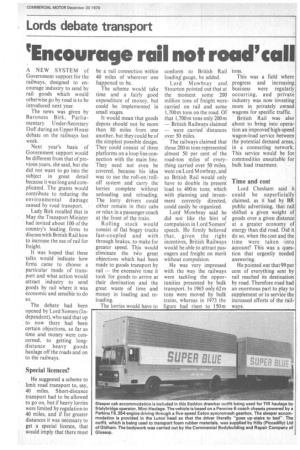'Encourage rail not road'call
Page 13

If you've noticed an error in this article please click here to report it so we can fix it.
A NEW SYSTEM of Government support for the railways, designed to encourage industry to send by rail goods which would otherwise go by road is to be introduced next year.
The news was given by Baroness Birk, Parliamentary Under-Secretary DoE during an Upper House debate on the railways last week.
Next year's basis of Government support would be different from that of previous years, she said, but she did not want to go into the subject in great detail because it was long and complicated. The grants would contribute to reducing the environmental damage caused by road transport.
Lady Birk recalled that in May the Transport Minister had invited about 100 of the country's leading, firms to discuss with British Rail how to increase the use of rail for freight.
It was hoped that these talks would indicate how firms came to choose a particular mode of transport and what action would attract industry to send goods by rail where it was economic and sensible to do so.
The debate had been opened by Lord Somers (Independent), who said that up to now there had been certain objections. so far as time and money were concerned, to getting longdistance heavy goods haulage off the roads and on to the railways.
Special licences?
He suggested a scheme to limit road transport to, say, 40 miles. Short-distance transport had to be allowed to go on, but if heavy lorries were limited by regulation to 40 miles, and if for greater distances it was necessary to get a special licence, that would imply that there must be a rail connection within 40 miles of wherever one happened to be.
The scheme would take time and a fairly good expenditure of money, but could be implemented in small stages.
It would mean that goods depots should not be more than 80 miles from one another, but they could be of the simplest possible design. They could consist of three platforms on a loop line connection with the main line. They need not even be covered, because his idea was to use the roll-on/rolloff system and carry the lorries complete without unloading and reloading. The lorry drivers could either remain in their cabs or relax in a passenger coach at the front of the train.
Rolling stock would consist of flat bogey trucks fast-coupled and with through brakes, to make for greater speed. This would eliminate the two great objections which had been made to goods transport by rail — the excessive time it took for goods to arrive at their destination and the great waste of time and money in loading and reloading.
The lorries would have to conform to British Rail loading' gauge, he added.
Lord Mowbray and Stourton pointed out that at the moment some 200 million tons of freight were carried on rail and some 1,700 m tons on the road. Of that 1,700 m tons only 200 m — British Railways claimed — were carried distances over 50 miles.
The railways claimed that those 200 m tons represented almost 50 per cent of the road-ton miles of everything carried over 50 miles, went on Lord Mowbray, and so British Rail would only have to double its present load to 400m tons; which with planning and investment correctly directed, could easily be organized.
Lord Mowbray said he did not like the hint of compulsion in Lord Somers' speech. He firmly believed that, given the right incentives, British Railways would be able to attract pasengers and freight on merit without compulsion.
He was very impressed with the way the railways were tackling the opportunities presented by bulk transport. In 1965 only 62m tons were moved by bulk trains, whereas in 1973 the figure had risen to 150m tons.
This was a field where progress and increasing business were regularly occurring, and private industry was now investing more in privately owned wagons for specific traffic.
British Rail was also about to bring into operation an improved high-speed wagon-load service between the potential demand areas, in a connecting network. This service would be for commodities unsuitable for bulk load treatment.
Time and cost
Lord Chesham said it could be superficially claimed, as it had by BR public advertising, that rail shifted a given weight of goods over a given distance at a greater economy of energy than did road. Did it do so, when the cost and the time were taken 'into account? This was a question that urgently needed answering.
He pointed out that 99 per cent of everything sent by rail reached its destination by road. Therefore road had an enormous part to play to supplement or to service the increased efforts of the railways.




















































































